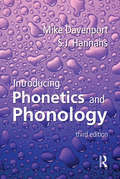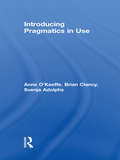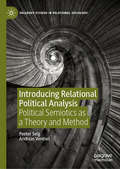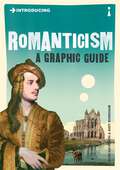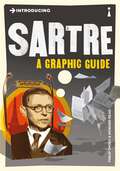- Table View
- List View
Introducing Multilingualism: A Social Approach
by Kristine Horner Jean Jacques WeberIntroducing Multilingualism is a comprehensive and user-friendly introduction to the dynamic field of multilingualism. Adopting a compelling social and critical approach and covering important social and educational issues, the authors expertly guide readers through the established theories, leading them to question dominant discourses on subjects such as integration, heritage and language testing. This second edition has been fully revised and updated, featuring new chapters on multilingualism in new media, the workplace and the family. Other key topics include: language as a social construct language contact and variation language and identity the differences between individual and societal multilingualism translanguaging flexible multilingual education. With a wide range of engaging activities and quizzes and a comprehensive selection of case studies from around the world, this is essential reading for undergraduate students and postgraduate students new to studying multilingualism.
Introducing Multilingualism: A Social Approach
by Kristine Horner Jean Jacques WeberIntroducing Multilingualism is a comprehensive and user-friendly introduction to the dynamic field of multilingualism. Adopting a compelling social and critical approach and covering important social and educational issues, the authors expertly guide readers through the established theories, leading them to question dominant discourses on subjects such as integration, heritage and language testing. This second edition has been fully revised and updated, featuring new chapters on multilingualism in new media, the workplace and the family. Other key topics include: language as a social construct language contact and variation language and identity the differences between individual and societal multilingualism translanguaging flexible multilingual education. With a wide range of engaging activities and quizzes and a comprehensive selection of case studies from around the world, this is essential reading for undergraduate students and postgraduate students new to studying multilingualism.
Introducing Multimodality
by Jeff Bezemer Carey Jewitt Kay O'HalloranThis accessible introduction to multimodality illuminates the potential of multimodal research for understanding the ways in which people communicate. Readers will become familiar with the key concepts and methods in various domains while learning how to engage critically with the notion of multimodality. The book challenges widely held assumptions about language and presents the practical steps involved in setting up a multimodal study, including: formulating research questions collecting research materials assessing and developing methods of transcription considering the ethical dimensions of multimodal research. A self-study guide is also included, designed as an optional stand-alone resource or as the basis for a short course. With a wide range of examples, clear practical support and a glossary of terms, Introducing Multimodality is an ideal reference for undergraduate and postgraduate students in multimodality, semiotics, applied linguistics and media and communication studies. Online materials, including colour images and more links to relevant resources, are available on the companion website at www.routledge.com/cw/jewitt and the Routledge Language and Communication Portal.
Introducing Multimodality
by Jeff Bezemer Carey Jewitt Kay O'HalloranThis accessible introduction to multimodality illuminates the potential of multimodal research for understanding the ways in which people communicate. Readers will become familiar with the key concepts and methods in various domains while learning how to engage critically with the notion of multimodality. The book challenges widely held assumptions about language and presents the practical steps involved in setting up a multimodal study, including: formulating research questions collecting research materials assessing and developing methods of transcription considering the ethical dimensions of multimodal research. A self-study guide is also included, designed as an optional stand-alone resource or as the basis for a short course. With a wide range of examples, clear practical support and a glossary of terms, Introducing Multimodality is an ideal reference for undergraduate and postgraduate students in multimodality, semiotics, applied linguistics and media and communication studies. Online materials, including colour images and more links to relevant resources, are available on the companion website at www.routledge.com/cw/jewitt and the Routledge Language and Communication Portal.
Introducing Performative Pragmatics
by Douglas RobinsonThis user-friendly introduction to a new ‘performative’ methodology in linguistic pragmatics breaks away from the traditional approach which understands language as a machine. Drawing on a wide spectrum of research and theory from the past thirty years in particular, Douglas Robinson presents a combination of ‘action-oriented approaches’ from sources such as J.L. Austin, H. Paul Grice, Harold Garfinkel and Erving Goffman. Paying particular attention to language as drama, the group regulation of language use, individual resistance to these regulatory pressures and nonverbal communication, the work also explains groundbreaking concepts and analytical models. With a key points section, discussion questions and exercises in every chapter, this book will be an invaluable resource to students and teachers on a variety of courses, including linguistic pragmatics, sociolinguistics and interpersonal communication.
Introducing Performative Pragmatics
by Douglas RobinsonThis user-friendly introduction to a new ‘performative’ methodology in linguistic pragmatics breaks away from the traditional approach which understands language as a machine. Drawing on a wide spectrum of research and theory from the past thirty years in particular, Douglas Robinson presents a combination of ‘action-oriented approaches’ from sources such as J.L. Austin, H. Paul Grice, Harold Garfinkel and Erving Goffman. Paying particular attention to language as drama, the group regulation of language use, individual resistance to these regulatory pressures and nonverbal communication, the work also explains groundbreaking concepts and analytical models. With a key points section, discussion questions and exercises in every chapter, this book will be an invaluable resource to students and teachers on a variety of courses, including linguistic pragmatics, sociolinguistics and interpersonal communication.
Introducing Phonetic Science (PDF)
by Michael Ashby John MaidmentThis accessible textbook provides a clear and practical introduction to phonetics, the study of speech. Assuming no prior knowledge of the topic, it introduces students to the fundamental concepts in phonetic science, and equips them with the essential skills needed for recognizing, describing and transcribing a range of speech sounds. Numerous graded exercises enable students to put these skills into practice, and the sounds introduced are clearly illustrated with examples from a variety of English accents and other languages. As well as looking at traditional articulatory description, the book introduces acoustic and other instrumental techniques for analysing speech, and covers topics such as speech and writing, the nature of transcription, hearing and speech perception, linguistic universals, and the basic concepts of phonology. Providing a solid foundation in phonetics, Introducing Phonetic Science will be invaluable to all students beginning courses in linguistics, speech sciences, language pathology and language therapy. Further exercises will be available on an accompanying website. 9780521004961 9780511808852
Introducing Phonetics and Phonology
by Mike Davenport S. J. HannahsThis book examines some of the ways in which linguists can express what native speakers know about the sound system of their language. Intended for the absolute beginner, it requires no previous background in linguistics, phonetics or phonology. Starting with a grounding in phonetics and phonological theory, the book provides a base from which more advanced treatments may be approached. It begins with an examination of the foundations of articulatory and acoustic phonetics, moves on to the basic principles of phonology, and ends with an outline of some further issues within contemporary phonology. Varieties of English, particularly Received Pronunciation and General American, form the focus of consideration, but aspects of the phonetics and phonology of other languages are discussed as well.This new edition includes more discussion of Optimality Theory and a new glossary of terms. It has been updated throughout to take account of the latest developments in phonological theory, but without sacrificing the book's ease of use for beginners.
Introducing Phonetics and Phonology
by Mike Davenport S. J. HannahsThis book examines some of the ways in which linguists can express what native speakers know about the sound system of their language. Intended for the absolute beginner, it requires no previous background in linguistics, phonetics or phonology. Starting with a grounding in phonetics and phonological theory, the book provides a base from which more advanced treatments may be approached. It begins with an examination of the foundations of articulatory and acoustic phonetics, moves on to the basic principles of phonology, and ends with an outline of some further issues within contemporary phonology. Varieties of English, particularly Received Pronunciation and General American, form the focus of consideration, but aspects of the phonetics and phonology of other languages are discussed as well.This new edition includes more discussion of Optimality Theory and a new glossary of terms. It has been updated throughout to take account of the latest developments in phonological theory, but without sacrificing the book's ease of use for beginners.
Introducing Phonetics and Phonology
by Mike Davenport S.J. HannahsIntended for the absolute beginner, Introducing Phonetics and Phonology requires no previous background in linguistics, phonetics or phonology. Starting with a grounding in phonetics and phonological theory, the book provides a base from which more advanced treatments may be approached. It begins with an examination of the foundations of articulatory and acoustic phonetics, moves on to the basic principles of phonology and ends with an outline of some further issues within contemporary phonology. Varieties of English, particularly Received Pronunciation and General American, form the focus of consideration, but aspects of the phonetics and phonology of other languages are discussed as well. This new edition includes revised exercises and examples; additional coverage of typology, autosegmental phonology and articulatory and acoustic phonetics; broader coverage of varieties that now features Australian English; and an extended Chapter 7 that includes more information on the relationship between phonetics and phonology.Introducing Phonetics and Phonology, 4th Edition remains the essential introduction for any students studying this topic for the first time.
Introducing Phonetics and Phonology
by Mike Davenport S.J. HannahsIntended for the absolute beginner, Introducing Phonetics and Phonology requires no previous background in linguistics, phonetics or phonology. Starting with a grounding in phonetics and phonological theory, the book provides a base from which more advanced treatments may be approached. It begins with an examination of the foundations of articulatory and acoustic phonetics, moves on to the basic principles of phonology and ends with an outline of some further issues within contemporary phonology. Varieties of English, particularly Received Pronunciation and General American, form the focus of consideration, but aspects of the phonetics and phonology of other languages are discussed as well. This new edition includes revised exercises and examples; additional coverage of typology, autosegmental phonology and articulatory and acoustic phonetics; broader coverage of varieties that now features Australian English; and an extended Chapter 7 that includes more information on the relationship between phonetics and phonology.Introducing Phonetics and Phonology, 4th Edition remains the essential introduction for any students studying this topic for the first time.
Introducing Pragmatics: A Clinical Approach
by Louise CummingsThis innovative, comprehensive course textbook uses a clinical approach to explore pragmatics and pragmatic language skills. Drawing on authentic, real-life examples of pragmatic breakdown in children and adults who have developmental or acquired language disorders, Louise Cummings expertly guides readers to core insights and principles for understanding where context and meaning in human communication meet. Key features include: Chapter-opening learning objectives and chapter-closing summaries. Authentic illustrative cases of atypical pragmatic interaction. Exercises for checking knowledge and understanding. Annotated recommended further reading. A detailed glossary of important terms in pragmatics and clinical linguistics. Aimed equally at undergraduate and graduate students who are coming to pragmatics for the first time, the text discusses the key issues and concepts of this field in a fascinating new way. With a common, easy-to-follow structure across chapters and a wealth of pedagogical resources, this is an essential text for students of linguistics and applied linguistics, communication studies, speech-language pathology, psychology and cognitive science, and beyond.
Introducing Pragmatics: A Clinical Approach
by Louise CummingsThis innovative, comprehensive course textbook uses a clinical approach to explore pragmatics and pragmatic language skills. Drawing on authentic, real-life examples of pragmatic breakdown in children and adults who have developmental or acquired language disorders, Louise Cummings expertly guides readers to core insights and principles for understanding where context and meaning in human communication meet. Key features include: Chapter-opening learning objectives and chapter-closing summaries. Authentic illustrative cases of atypical pragmatic interaction. Exercises for checking knowledge and understanding. Annotated recommended further reading. A detailed glossary of important terms in pragmatics and clinical linguistics. Aimed equally at undergraduate and graduate students who are coming to pragmatics for the first time, the text discusses the key issues and concepts of this field in a fascinating new way. With a common, easy-to-follow structure across chapters and a wealth of pedagogical resources, this is an essential text for students of linguistics and applied linguistics, communication studies, speech-language pathology, psychology and cognitive science, and beyond.
Introducing Pragmatics in Use
by Anne O'Keeffe Brian Clancy Svenja AdolphsIntroducing Pragmatics in Use is a lively and accessible introduction to pragmatics, which both covers theory and applies it to real spoken and written data. Pragmatics is the study of language in context, yet most textbooks rely on invented language examples. This innovative textbook systematically draws on language corpora to illustrate features such as creativity in small talk or how we apologise in English. The authors investigate the pragmatic implications of the globalisation of the English language and focus on the applications of pragmatics for teaching languages. In addition, a practical chapter on researching pragmatics aimed at developing students’ research skills is included. With a range of tasks aimed at putting theory into practice and chapter by chapter further reading recommendations, this is the ideal textbook for advanced undergraduate or postgraduate students of pragmatics and corpus linguistics within applied language/linguistics or TEFL/TESOL degrees.
Introducing Pragmatics in Use
by Anne O'Keeffe Brian Clancy Svenja AdolphsIntroducing Pragmatics in Use is a lively and accessible introduction to pragmatics, which both covers theory and applies it to real spoken and written data. Pragmatics is the study of language in context, yet most textbooks rely on invented language examples. This innovative textbook systematically draws on language corpora to illustrate features such as creativity in small talk or how we apologise in English. The authors investigate the pragmatic implications of the globalisation of the English language and focus on the applications of pragmatics for teaching languages. In addition, a practical chapter on researching pragmatics aimed at developing students’ research skills is included. With a range of tasks aimed at putting theory into practice and chapter by chapter further reading recommendations, this is the ideal textbook for advanced undergraduate or postgraduate students of pragmatics and corpus linguistics within applied language/linguistics or TEFL/TESOL degrees.
Introducing Pragmatics in Use
by Anne O'Keeffe Brian Clancy Svenja AdolphsIntroducing Pragmatics in Use is a lively and accessible introduction to pragmatics which both covers theory and applies it to real spoken and written data. This textbook systematically draws on a number of different language corpora and the corresponding software applications. Its primary focus is the application of a corpus methodology in order to examine core component areas such as deixis, politeness, speech acts, language variation and register. The main goal of the book is to contextualise pragmatics in the study of language through the analysis of different language contexts provided by spoken and written corpora. Substantially revised and updated, this second edition covers a wider range of topics, corpora and software packages. It consistently demonstrates the benefits of innovative analytical synergies and extends this to how corpus pragmatics can be further blended with, for example, conversation analysis or variational pragmatics. The second edition also offers a new chapter specifically dedicated to corpus pragmatics which proposes a framework for both form-to-function and function-to-form approaches. The book also addresses the – sometimes thorny – area of the integration of the teaching of pragmatics into the language classroom. All chapters in the second edition include a number of cohesive, step-by-step tasks that can be done in small groups in class or can be used as self-study resources. A wide range of illustrative language samples drawn from a number of English language corpora, coupled with instructive tasks and annotated further reading sections, make this an ideal textbook for advanced undergraduate or postgraduate students of pragmatics, discourse analysis and corpus linguistics within applied languages / linguistics or TESOL programmes.
Introducing Pragmatics in Use
by Anne O'Keeffe Brian Clancy Svenja AdolphsIntroducing Pragmatics in Use is a lively and accessible introduction to pragmatics which both covers theory and applies it to real spoken and written data. This textbook systematically draws on a number of different language corpora and the corresponding software applications. Its primary focus is the application of a corpus methodology in order to examine core component areas such as deixis, politeness, speech acts, language variation and register. The main goal of the book is to contextualise pragmatics in the study of language through the analysis of different language contexts provided by spoken and written corpora. Substantially revised and updated, this second edition covers a wider range of topics, corpora and software packages. It consistently demonstrates the benefits of innovative analytical synergies and extends this to how corpus pragmatics can be further blended with, for example, conversation analysis or variational pragmatics. The second edition also offers a new chapter specifically dedicated to corpus pragmatics which proposes a framework for both form-to-function and function-to-form approaches. The book also addresses the – sometimes thorny – area of the integration of the teaching of pragmatics into the language classroom. All chapters in the second edition include a number of cohesive, step-by-step tasks that can be done in small groups in class or can be used as self-study resources. A wide range of illustrative language samples drawn from a number of English language corpora, coupled with instructive tasks and annotated further reading sections, make this an ideal textbook for advanced undergraduate or postgraduate students of pragmatics, discourse analysis and corpus linguistics within applied languages / linguistics or TESOL programmes.
Introducing Psycholinguistics (PDF)
by Paul WarrenHow humans produce and understand language is clearly introduced in this textbook for students with only a basic knowledge of linguistics. With a logical, flexible structure Introducing Psycholinguistics steps through the central topics of production and comprehension of language and the interaction between them. Students will gain an understanding of the processes and representations involved in language use, aided by a comprehensive glossary, concepts defined in the margins and online flashcards that allow students to check their understanding of all the key terms and concepts of the subject. Examples and exercises throughout each topic reinforce understanding and encourage students to consider what language users might carry around in their heads as part of their linguistic knowledge, and how this stored knowledge relates to the structures and rules proposed by theoretical linguistics. Students will gain hands-on experience of experimental methods, with online demonstrations of techniques. This supports the theory within the book, reinforces a student's grasp of the concepts and allows the student to apply their understanding to the analysis of data.
Introducing Relational Political Analysis: Political Semiotics as a Theory and Method (Palgrave Studies in Relational Sociology)
by Peeter Selg Andreas VentselThis book introduces relational thinking to political analysis. Instead of merely providing an overview of possible trajectories for articulating a relational political analysis, Peeter Selg and Andreas Ventsel put forth a concrete relational theory of the political, which has implications for research methodology, culminating in a concrete method they call political form analysis. In addition, they sketch out several applications of this theory, methodology and method. They call their approach “political semiotics” and argue that it is a fruitful way of conducting research on power, governance and democracy – the core dimensions of the political – in a manner that is envisioned in numerous discussions of the “relational turn” in the social sciences. It is the first monograph that attempts to outline an approach to the political that would be relational throughout, from its meta theoretical and theoretical premises through to its methodological implications, methods and empirical applications.
Introducing Researching English for Specific Purposes (Routledge Introductions to English for Specific Purposes)
by Lindy WoodrowIntroducing Researching English for Specific Purposes is an accessible and practical guide to research in ESP. It’s for novice researchers, graduate students and for ESP practitioners who want to do some research themselves. The author takes the reader step by step through the stages of research, starting with choosing a topic and reviewing the literature though to writing up research findings. Examples are taken from academic journals and dissertations to highlight aspects of the research process. The book covers the following areas: developing a research project research design theoretical approaches to ESP research choosing a research topic quantitative, qualitative and mixed methods in ESP research validity, reliability and ethics writing up research in ESP The book includes recommendations for further reading and tasks. There is also a glossary and a chapter providing advice, templates and links to useful research sources. Introducing Researching English for Specific Purposes is essential reading for anyone wanting to conduct research in ESP.
Introducing Researching English for Specific Purposes (Routledge Introductions to English for Specific Purposes)
by Lindy WoodrowIntroducing Researching English for Specific Purposes is an accessible and practical guide to research in ESP. It’s for novice researchers, graduate students and for ESP practitioners who want to do some research themselves. The author takes the reader step by step through the stages of research, starting with choosing a topic and reviewing the literature though to writing up research findings. Examples are taken from academic journals and dissertations to highlight aspects of the research process. The book covers the following areas: developing a research project research design theoretical approaches to ESP research choosing a research topic quantitative, qualitative and mixed methods in ESP research validity, reliability and ethics writing up research in ESP The book includes recommendations for further reading and tasks. There is also a glossary and a chapter providing advice, templates and links to useful research sources. Introducing Researching English for Specific Purposes is essential reading for anyone wanting to conduct research in ESP.
Introducing Romanticism: A Graphic Guide (Introducing...)
by Duncan HeathPhilosophy, art, literature, music, and politics were all transformed in the turbulent period between the French Revolution of 1789 and the Communist Manifesto of 1848. This was the age of the 'Romantic revolution', when modern attitudes to political and artistic freedom were born. When we think of Romanticism, flamboyant figures such as Byron or Shelley instantly spring to mind, but what about Napoleon or Hegel, Turner or Blake, Wagner or Marx? How was it that Romanticism could give birth to passionate individualism and chauvinistic nationalism at the same time? How did it prefigure the totalitarian movements of the 20th century? Duncan Heath and Judy Boreham answer these questions and provide a unique overview of the many interlocking strands of Romanticism, focusing on the leading figures in Britain, Germany, France, Italy, Russia and America.
Introducing Sartre: A Graphic Guide (Introducing...)
by Philip ThodyINTRODUCING guide to the father of existentialism and one of 20th century philosophy's most famous characters. Jean-Paul Sartre was once described as being, next to Charles de Gaulle, the most famous Frenchman of the 20th century. Between the ending of the Second World War in 1945 and his death in 1980, Sartre was certainly the most famous French writer, as well as one of the best-known living philosophers. Introducing Sartre explains the basic ideas inspiring his world view, and pays particular attention to his idea of freedom. It also places his thinking on literature in the context of the 20th century debate on its nature and function. It examines his ideas on Marxism, his enthusiasm for the student rebellion of 1968, and his support for movements of national liberation in the Third World. The book also provides a succinct account of his life, and especially of the impact which his unusual childhood had on his attitude towards French society.
Introducing Second Language Acquisition: Perspectives and Practices (Linguistics in the World)
by Kirsten M. HummelIntroducing Second Language Acquisition: Perspectives and Practices represents a clear and concise introduction to the main concepts, issues, and debates in second language acquisition studies aimed specifically at undergraduates encountering the topic for the first time. Follows six fictitious language learners throughout the text whose stories serve to introduce various concepts and issues Contains specific chapters on first language acquisition and bilingualism, as well as explicit references to the most recent and important research Covers key topics including acquisition contexts, theoretical perspectives, language teaching methods, second language development, and individual differences (such as age, aptitude, and motivation) Grabs student attention with lighthearted cartoons that illustrate and reinforce key ideas Features a full range of pedagogical tools to aid student learning, including “language learning in practice” textboxes; bolded new terms defined in the margins; an end-of-book glossary; self-assessment and classroom discussion questions; exercise and project ideas; and further online viewing sections
Introducing Second Language Acquisition: Perspectives and Practices (Linguistics in the World)
by Kirsten M. HummelIntroducing Second Language Acquisition: Perspectives and Practices represents a clear and concise introduction to the main concepts, issues, and debates in second language acquisition studies aimed specifically at undergraduates encountering the topic for the first time. Follows six fictitious language learners throughout the text whose stories serve to introduce various concepts and issues Contains specific chapters on first language acquisition and bilingualism, as well as explicit references to the most recent and important research Covers key topics including acquisition contexts, theoretical perspectives, language teaching methods, second language development, and individual differences (such as age, aptitude, and motivation) Grabs student attention with lighthearted cartoons that illustrate and reinforce key ideas Features a full range of pedagogical tools to aid student learning, including “language learning in practice” textboxes; bolded new terms defined in the margins; an end-of-book glossary; self-assessment and classroom discussion questions; exercise and project ideas; and further online viewing sections




